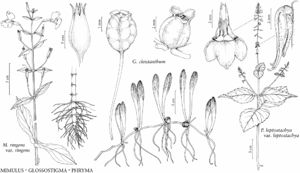Glossostigma cleistanthum
J. Adelaide Bot. Gard. 15: 72. 1992.
Roots (3–)5(or 6) per node. Stolons creeping along substrate surface, internodes 1–18 mm. Leaves: blade erect, green or yellow-green, narrowly spatulate, 4–11 mm emersed, (7–)9–25(–57) mm submersed, base with a pair of longitudinal lacunae, glossy. Pedicels 4–15 mm (chasmogamous), 0–2 mm (cleistogamous). Flowers dimorphic, chasmogamous and/or cleistogamous emersed, cleistogamous submersed; calyx green, red, or brown, campanulate, 1 mm (chasmogamous), urceolate, 1.5–3 mm (cleistogamous), lobes spreading, equal to or shorter than tube, obtuse; corolla 5-lobed (chasmogamous), tube 0.6 mm, abaxial lobe 0.5–0.7 mm, adaxial lobes 0.2 mm, lateral lobes 0.3–0.5 mm, lobes distinct, obtuse, roundish, spreading or corolla rudimentary (cleistogamous); stamens exserted 0.1–0.2 mm; stigma 1 mm, exserted, inrolled over anthers distally, straightening when touched, adaxial surface papillate, receptive (chasmogamous), or smaller, elliptic, non-tactile (cleistogamous). Capsules oblong (chasmogamous) or globular (cleistogamous), 1.4–1.8 mm. Seeds oblong, 0.4–0.5 mm. 2n = 50 (New Zealand).
Phenology: Flowering spring–fall; fruiting summer–winter.
Habitat: Fresh, oligotrophic waters to 26 dm, margins of coastal plain lakes, ponds, and watercourses, on sand or sandy substrates mixed with clay, gravel, or silt.
Elevation: 10–200 m.
Distribution
Introduced; Conn., Del., Md., Mass., N.J., Pa., R.I., Pacific Islands (New Zealand), Australia.
Discussion
North American plants initially were misidentified as Glossostigma diandrum due to the presence of chasmogamous flowers, which had not been reported in G. cleistanthum. Field and genetic studies confirmed that all known cleistogamous and chasmogamous North American plants belonged to G. cleistanthum (D. H. Les et al. 2006).
When submersed, Glossostigma cleistanthum is perennial (perhaps also annual) and can remain green throughout winter, even under ice. Submersed plants produce only cleistogamous flowers but longer leaves and stolon internodes. Emersed plants have shorter leaves and stolons and are annual in the flora area. They produce cleistogamous and/or chasmogamous flowers; however, the latter are observed infrequently in North America.
In chasmogamous flowers, the apex of the flaplike stigma curls inward to cover the anthers but quickly straightens, displacing the receptive surface against the adaxial corolla when contacted; it then slowly recurls to cover the anthers. Despite this presumed adaptation for outcrossing, autogamy occurs frequently by means of the cleistogamous flowers. Seed set and germination typically are high. Seed production is prodigious, reaching densities of 23,000 seeds m2.
Glossostigma is regulated as a noxious aquatic weed even in the states of Oklahoma and Washington, which are quite remote from any of the known populations. Though small, these plants are seriously invasive because they can become dense (to 25,000 plants m2) in some sites, displacing imperiled native species. Sterile or cleistogamous plants easily avoid detection because they often resemble masses of seedlings. Dispersal occurs by transport of seeds (in mud or feathers of waterfowl), or locally by dislodged fruit-bearing plants, which float. Chasmogamous flowers exhibit splash-cup seed dispersal. The Delaware and Maryland attributions are based on photographs sent to us by Wayne Longbottom (W. M. Knapp et al. 2011). The presence of G. cleistanthum in New York is probable but not documented.
The use of Glossostigma as an aquarium plant (C. Kasselmann 2003) likely is associated with its introduction to North America. The first documented North American specimens were collected from a tidal freshwater wetland in New London County, Connecticut, in 1992.
Selected References
None.
